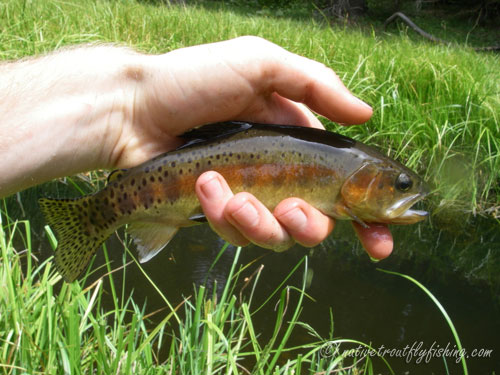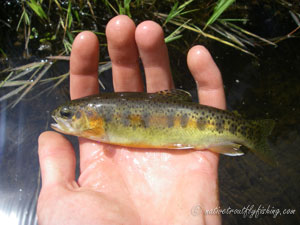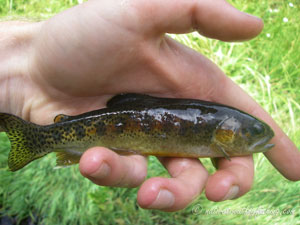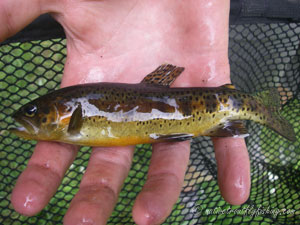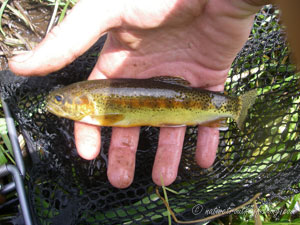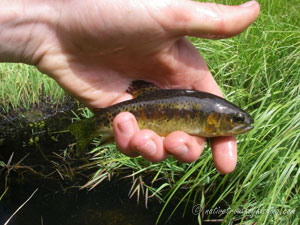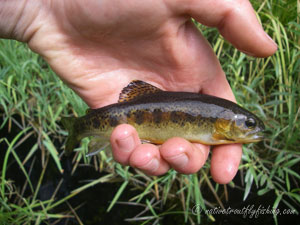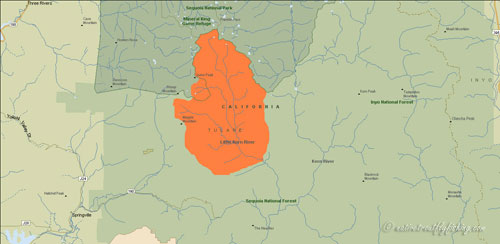Little Kern Golden Trout
Oncorhynchus mykiss whitei
A Little Kern Golden Trout from a meadow stream in the Sierras
Introduction
The Little Kern Golden Trout are native to the Little Kern River and its tributaries in California. Little Kern Golden Trout have been isolated from other forms of trout for at least 10,000 years and are most closely related to the California Golden Trout of the South Fork of the Kern River and Golden Trout Creek (Behnke 2002, Stephens 2007). Originally, the Little Kern Golden Trout were described as a distinct species, Salmo whitei (Evermann 1905), but both taxonomic and genetic studies indicate that they are derived Rainbow/ Redband Trout and are considered a subspecies of Rainbow Trout (Behnke 2002, Moyle 2002, Stephens 2007). Little Kern Golden Trout rival the beauty of the California Golden Trout but have slightly more subdued coloration.
Life History Information
The Little Kern River drainage is comprised of small stream habitat and as such these fish only exhibit a stream resident life history. Under these conditions the Little Kern Golden Trout reach a maximum size of about 12 inches (30 cm), with an average size of about 5 to 7 inches (13 to 18 cm) (Behnke 2002). These trout usually reach sexual maturity at about 3-4 years old, although some males have been known to mature at age-2 (USFWS 2011). Spawning generally occurs in late May or early June after spring runoff has subsided with fish selecting sites in the tail outs. Spawning lasts between two to seven days and the typical female will lay between 41 and 65 eggs per year, which hatch after about 26 days at 54 to 61 °F (12-16 °C) (USFWS 2007). The preferred habitat of the Little Kern Golden Trout is pools with undercut banks and their diet is made up of aquatic and terrestrial insects.
Status
In 1978 the Little Kern Golden Trout was listed as threatened under the Endangered Species Act, when it became evident that these fish were vanishing throughout much of their native range (USFWS 1978). At the time the Little Kern Golden Trout was listed, its range had shrunk from 100 miles (160 km) of habitat to just ten miles (16 km) of small, isolated streams (Moyle et al. 2008) and it was estimated that only 4,500 pure fish remained (Moyle et al. 2017). The leading causes of the decline of the Little Kern Golden Trout was the introduction of non-native trout and habitat degradation. Like other isolated subspecies of trout, the Little Kern Golden Trout are very poor competitors, and the introduction of Brown Trout Brook Trout and Rainbow Trout has devastating impacts on them. From 1931 to 1941, the streams of the Little Kern River were planted with 85,000 to 100,000 hatchery Rainbow Trout annually (Gold and Gold 1976). This resulted in significant hybridization with introduced Rainbow Trout, which dilutes the gene pool and eventually leaves a hybrid swarm behind where a pure population once existed. Livestock grazing also occurs in the watershed and can have a significant impact on quality of habitat available to these fish. Effects on habitat include increased sedimentation and nutrient loads, changes in stream channel morphology and a reduction of shade and cover (Knapp and Mathews 1996). Although not as significant in their impact, there are approximately 150 miles of trails in the Little Kern drainage and recreational use of the area may have negative impacts on the fish, with pack animals having similar impacts as grazing by livestock (USFWS 2007).
While the range of the Little Kern Golden Trout has been greatly reduced, significant efforts have been made to recover the Little Kern Golden Trout since their listing. Between 1974 and 1996, the California Department of Fish and Wildlife (CDFW) made approximately 100 applications of piscicides, transplanted 80,000 Little Kern Golden Trout, and constructed 27 barriers to remove non-native trout and isolate recovered Little Kern Golden Trout populations (Lusardi et al. 2015). These efforts have proved largely successful as the range of the Little Kern Golden Trout has been expanded to 32 miles (51 km) of streams and three headwater lakes and Brown Trout have been completely removed from the basin (Moyle et al. 2017). Unfortunately, hatchery Rainbow Trout were unintentionally included in the hatchery broodstock for Little Kern Golden Trout, with the progeny of these fish being planted back into the wild, resulting in a set back to the recovery of Little Kern Golden Trout (CDFG 2006). Genetics results. Indicate that 85% of the current populations have less than 5% ingression with hatchery Rainbow Trout (Stephens 2007). While significant progress has been made on reducing the influence of hatchery Rainbow Trout in the basin, an unfortunate side effect of recovery efforts being based on small, isolated populations, has been a loss of genetic diversity due to genetic drift and inbreeding (Lusardi et al. 2015). Most recent abundance estimates indicate that there are likely around 15,000 Little Kern Golden Trout remaining (Moyle et al. 2017), but there is still a long way to go until the populations of this beautiful trout are fully recovered.
Description
The Little Kern Golden Trout has a slightly subdued coloration when compared to the California Golden Trout and is somewhat intermediate between the California Golden and the Kern River Rainbow Trout. Little Kern Golden Trout is an olive-green or coppery color on the back and transitions to golden yellow color below the lateral line, which can be quite bright on some individuals and dull on others. The belly on these fish is often an orange color like that found on the other two Kern drainage subspecies. Purplish oval parr marks are typically retained throughout the life of these fish and are typically more prominent than those on the California Golden Trout. The lateral band on the Little Kern Golden Trout is a red-orange color with same coloration is found on the gill plates. The spots on the Little Kern Golden Trout are generally only found above the lateral line and on the caudal and dorsal fins and they typically have more and smaller spots than the California Golden. The fins are an orange or yellow color, and the dorsal, anal, and pelvic fins have a dark border tipped with white or orange.
Stream Resident Form
Click on images to view a larger picture
Native Range
A map of the native range of the Little Kern Golden trout. Data Source: Behnke (2002).
References
Behnke, R. 2002. Trout and Salmon of North America. Chanticleer Press, New York.
CDFG (California Department of Fish and Game). 2006. 1984 Revised fishery management plan for the Little Kern Golden Trout. California Department of Fish and Game, Sacramento, CA.
Evermann, B.W. 1905. Golden Trout of the southern high Sierras. Department of Commerce and Labor. Bureau of Fisheries. Bulletin of the Bureau of Fisheries 25: 1-51..
Knapp, R.A. and Matthews, K.R. 1996. Livestock grazing, golden trout and streams in the Golden Trout Wilderness, California: Impacts and management implications. North American Journal of Fisheries Management 16: 805-820.
Moyle, P. 2002. Inland Fishes of California, 2nd Edition. Berkeley, University of California Press.
Moyle, P.B., Israel, J.A. and Purdy, S.E. 2008. SOS: California's native fish crisis: Status of and solutions for restoring our vital salmon, steelhead and trout populations. California Trout, San Francisco, CA.
Moyle, P.B., R.A. Lusardi, P.J. Samuel and J.V.E. Katz. 2017. State of the salmonids: status of California's emblematic fishes 2017. Center for Watershed Sciences, University of California, Davis and California Trout, San Francisco, CA. 579 pp.
Stephens, M.R. 2007. Systematics, genetics and conservation of Golden Trout. Dissertation. University of California, Davis, California.
USFWS (U.S. Fish and Wildlife Service). 1978. Final determination of threatened status with critical habitat for the Little Kern Golden Trout. Federal Register 43:15427-15429.
USFWS (United States Fish and Wildlife Service). 2007. Species account: Little Kern golden trout. United States Fish and Wildlife Service, Sacramento, CA.
USFWS. 2011. Little Kern Golden Trout (Oncorhynchus mykiss whitei). 5-year review: Summary and evaluation. United States Fish and Wildlife Service, Sacramento, CA.
Contact
Feel free to contact me if you have any questions or comments
Little Kern Golden Trout Links
California Department of Fish and Wildlife - Little Kern Golden Trout Angling
Lower Kern River - Sequoia National Forest
Western Native Trout Initiative - Little Kern Golden Trout
Native Trout Links
Truchas Mexicanas' - Native Trout of Mexico
Balkan Trout Restoration Group
Trout and Seasons of the Mountain Village - About Japanese Trout
Western Native Trout Challenge
California Heritage Trout Challenge
Fly Fishing Blogs
Dave B's Blog: Fly Fishing for Native Trout
The Search for Native Salmonids
Conservation Links
Western Native Trout Initiative
Fly Fishing Links
Fishing Art Links
Americanfishes.com - Joseph R. Tomelleri
